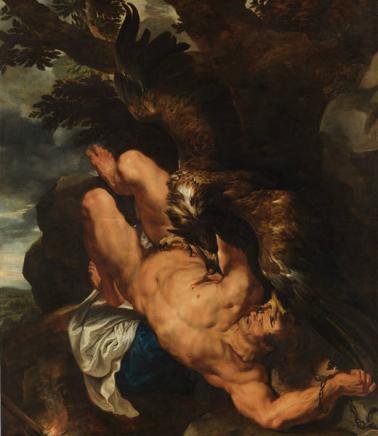
The "Furias" first appeared as a group in art in 1548 when Mary of Hungary commissioned Titian to paint four canvases for her palace at Binche (on the outskirts of Brussels) depicting Tityus, Tantalus, Sisyphus and Ixion, figures whom she associated with the German princes who had rebelled against her brother, the Emperor Charles V, and whom he had defeated the year before at Mühlberg.
In Spain, the name the "Furias" was applied to four figures who dwelled in the Graeco-Roman Hades as a punishment for defying the gods: Tityus, whose liver was constantly pecked at by a vulture for attempting to rape one of Zeus's lovers; Tantalus, condemned to vainly try to obtain food and drink for serving up his son at a banquet of the gods; Sisyphus, who had to endlessly roll an enormous rock for revealing Zeus's infidelities; and Ixion, obliged to turn forever on a wheel for attempting to seduce Hera. Strictly speaking, the Furies were female figures who personified punishment and vengeance and were responsible for ensuring that those in Hades underwent their punishments. In Spain, however, and from the 16th century onwards the name was used for Titian's canvases of Tityus, Ixion, Tantalus and Sisyphus, and the term thus became used for the subject in general.
The "Furias" became a popular iconography in the 120 years after their first appearance, taking on further meanings in addition to their original, political one. From the late 16th century onwards the subject was considered highly appropriate for illustrating supreme mastery in art, given that they are monumental, nude figures in complex foreshortenings and also represent extreme suffering, which appealed to the Baroque sensibility. They were thus used by leading artists such as Rubens, Goltzius and Van Haarlem to demonstrate their skills, and by Ribera and Rombouts to give visual form to the aesthetic of horror in vogue in Europe at the time. However, after a peak of interest in Naples with Ribera and in Venice with Langetti, from around 1680 artists began to make less use of this subject, which was replaced around 1700 by others that allowed similar concepts to be expressed.
The "Furias". From Titian to Ribera
Museo del Prado, Madrid
21 January - 4 May
